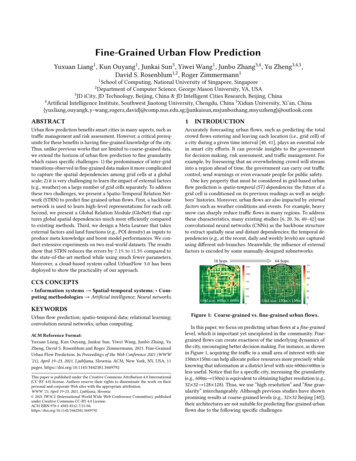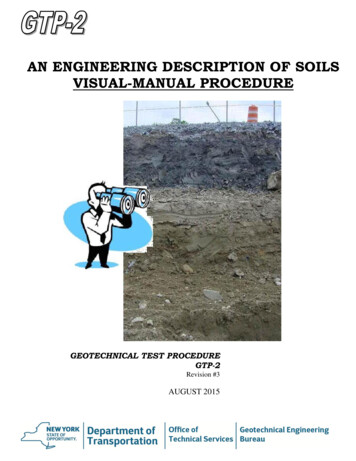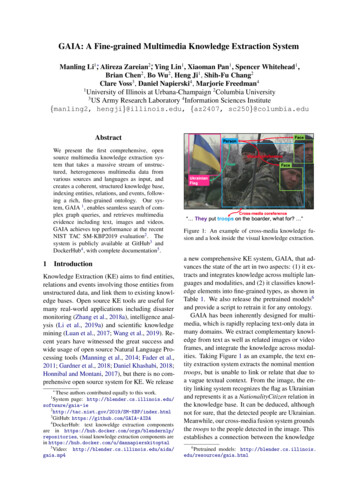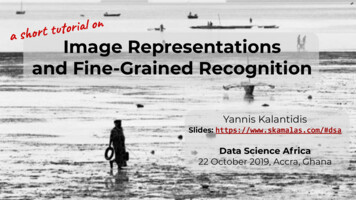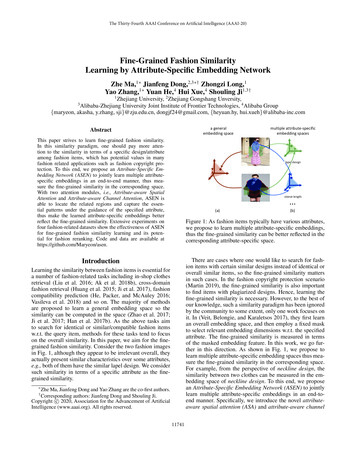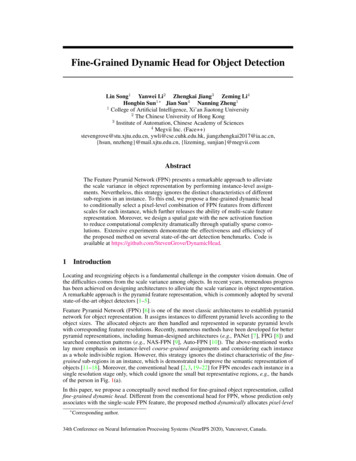
Transcription
Fine-Grained Dynamic Head for Object DetectionLin Song1 Yanwei Li2 Zhengkai Jiang3 Zeming Li4Hongbin Sun1 Jian Sun4 Nanning Zheng11College of Artificial Intelligence, Xi’an Jiaotong University2The Chinese University of Hong Kong3Institute of Automation, Chinese Academy of Sciences4Megvii Inc. (Face )stevengrove@stu.xjtu.edu.cn, ywli@cse.cuhk.edu.hk, jiangzhengkai2017@ia.ac.cn,{hsun, nnzheng}@mail.xjtu.edu.cn, {lizeming, sunjian}@megvii.comAbstractThe Feature Pyramid Network (FPN) presents a remarkable approach to alleviatethe scale variance in object representation by performing instance-level assignments. Nevertheless, this strategy ignores the distinct characteristics of differentsub-regions in an instance. To this end, we propose a fine-grained dynamic headto conditionally select a pixel-level combination of FPN features from differentscales for each instance, which further releases the ability of multi-scale featurerepresentation. Moreover, we design a spatial gate with the new activation functionto reduce computational complexity dramatically through spatially sparse convolutions. Extensive experiments demonstrate the effectiveness and efficiency ofthe proposed method on several state-of-the-art detection benchmarks. Code isavailable at uctionLocating and recognizing objects is a fundamental challenge in the computer vision domain. One ofthe difficulties comes from the scale variance among objects. In recent years, tremendous progresshas been achieved on designing architectures to alleviate the scale variance in object representation.A remarkable approach is the pyramid feature representation, which is commonly adopted by severalstate-of-the-art object detectors [1–5].Feature Pyramid Network (FPN) [6] is one of the most classic architectures to establish pyramidnetwork for object representation. It assigns instances to different pyramid levels according to theobject sizes. The allocated objects are then handled and represented in separate pyramid levelswith corresponding feature resolutions. Recently, numerous methods have been developed for betterpyramid representations, including human-designed architectures (e.g., PANet [7], FPG [8]) andsearched connection patterns (e.g., NAS-FPN [9], Auto-FPN [10]). The above-mentioned workslay more emphasis on instance-level coarse-grained assignments and considering each instanceas a whole indivisible region. However, this strategy ignores the distinct characteristic of the finegrained sub-regions in an instance, which is demonstrated to improve the semantic representation ofobjects [11–18]. Moreover, the conventional head [2, 3, 19–22] for FPN encodes each instance in asingle resolution stage only, which could ignore the small but representative regions, e.g., the handsof the person in Fig. 1(a).In this paper, we propose a conceptually novel method for fine-grained object representation, calledfine-grained dynamic head. Different from the conventional head for FPN, whose prediction onlyassociates with the single-scale FPN feature, the proposed method dynamically allocates pixel-level Corresponding author.34th Conference on Neural Information Processing Systems (NeurIPS 2020), Vancouver, Canada.
(a) Conventional head in a single scale(b) Dynamic head in a single scaleFigure 1: Comparisons between the conventional head and the proposed dynamic head in a singlescale. In the conventional head, the output feature of an instance only associates with a single-scaleFPN feature. With the fine-grained routing process, the proposed dynamic head selects a combinationof pixel-level sub-regions from multiple FPN stages.sub-regions to different resolution stages and aggregates them for the finer representation, as presentedin Fig. 1(b). To be more specific, motivated by the coarse-grained dynamic routing [23–26], wedesign a fine-grained dynamic routing space for the head, which consists of several fine-graineddynamic routers and three kinds of paths for each router. The fine-grained dynamic router is proposedto conditionally select the appropriate sub-regions for each path by using the data-dependent spatialgates. Meanwhile, these paths are made up of a set of pre-defined networks in different FPN scalesand depths, which transform the features in the selected sub-regions. Different from the coarsegrained dynamic routing methods, our routing process is performed in pixel-level and thus achievesfine-grained object representation. Moreover, we propose a new activation function for the spatialgate to reduce computational complexity dramatically through spatially sparse convolutions [27].Specifically, with the given resource budgets, more resources could be allocated to “hard” positivesamples than “easy” negative samples.Overall, the proposed dynamic head is fundamentally different from existing methods for head designs.Our approach exploits a new dimension: dynamic routing mechanism is utilized for fine-grainedobject representation with efficiency. The designed method can be easily instantiated on severalFPN-based object detectors [2, 3, 5, 20, 21] for better performance. Moreover, extensive ablationstudies have been conducted to elaborate on its superiority in both effectiveness and efficiency, whichachieve consistent improvements with little computational overhead. For instance, with the proposeddynamic head, the FCOS [3] based on the ResNet-50 [28] backbone attains 2.3% mAP absolute gainswith less computational cost on the COCO [29] dataset.2MethodIn this section, we first propose a routing space for the fine-grained dynamic head. And then, thefine-grained dynamic routing process is elaborated. At last, we present the optimization process withresource budget constraints.2.1Fine-Grained Dynamic Routing SpaceFPN-based detection networks [2, 3, 20, 21] first extract multiple features from different levelsthrough a backbone feature extractor. And then, semantically strong features in low-resolution andsemantically weak features in high-resolution are combined through the top-bottom pathway andlateral connections. After obtaining features from the pyramid network, a head is adopted for eachFPN scale, which consists of several convolution blocks and shares parameters across different scales.The head further refines the semantic and localization features for classification and box regression.To release pixel-level feature representation ability, we propose a new fine-grained dynamic head toreplace the original one, which is shown in Fig. 2. Specifically, for n-th stage, a space with D depthsand three adjacent scales is designed for a fine-grained dynamic head, namely fine-grained dynamicrouting space. In this routing space, the scaling factor between adjacent stages is restricted to 2. The2
123D-2D-1D.Stage n 1Fine-grainedDynamic RouterxlClassificationDepth Path.Stage nSpatialGatesmlRegressionScale (up) PathStage n-1y1,l y 2,l y 3,lCenterness.Scale (down) PathRouting ProcessDynamic HeadFigure 2: The diagram of the routing space for the fine-grained dynamic head. ‘Stage n-1’, ‘Stage n’and ‘Stage n 1’ represent three adjacent FPN scales, respectively. The dynamic head (marked bythe dashed rectangle) for each stage includes D fine-grained dynamic routers, where each router hasup to three alternative paths. The router first aggregates the multiple input features by performingelement-wise accumulation. And then, for each pixel-level location, the router dynamically selectssubsequent paths, which is elaborated in ‘Routing Process’.basic unit, called fine-grained dynamic router, is utilized to select subsequent paths for each pixelconditionally. In order to take advantages of distinct properties of the different scale features, wepropose three kinds of paths with different scales for each router, which are elaborated in Sec. 2.2.3.Following common protocols [2, 3, 20, 21], we adopt the ResNet [28] as the backbone. The featurepyramid network is configured like the original design [6] with simple up-sampling operations, whichoutputs augmented multi-scale features, i.e., {P3, P4, P5, P6, P7}. The channel number of eachfeature is fixed to 256.2.2Fine-Grained Dynamic Routing ProcessGiven the routing space with several individual nodes, we propose fine-grained dynamic routers foreach router to aggregate multi-scale features by performing element-wise accumulation and choosepixel-level routing paths. This routing process of a dynamic router is briefly illustrated in Fig. 2.2.2.1Fine-Grained Dynamic RouterGiven a node l, the accumulation of multiple input features is denoted as xl {xli }Ni 1 withN (N H W ) pixel-level locations and C channels. We define a set of paths according to theadjacent FPN scales, which is denoted as F {fkl (·) k {1, ., K}}. To dynamically control theon-off state of each path, we set up a fine-grained dynamic router with K spatial gates, where theoutput of the spatial gate is defined as gating factor. The gating factor of the k-th spatial gate in i-th(i {1, ., N }) location can be represented byll lmk,li gk (xi ; θk ),(1)where θkl denotes the parameters of the partial network corresponding to the k-th spatial gate andshares parameters in each location. The conventional evolution or reinforcement learning basedmethods [4, 9, 10] adopt metaheuristic optimization algorithm or policy gradient to update the agentfor discrete path selection, i.e., mk,li {0, 1}. Different from those methods, motivated by [30], werelax the discrete space of the gating factor to a continuous one, i.e., mk,li [0, 1].Since the gating factor mk,li can reflect the estimated probability of the path being enabled, we definethe list of weighted output from each path as the router output. This router output is formulated asEq. 2, where only paths with a positive gating factor are enabled. It is worth noting that, unlike manyrelated methods [23–25, 31, 32], our router allows multiple paths to be enabled simultaneously for asingle location.llyil {yik,l yik,l mk,li · fk (xi ), k Ωi },where Ωi {k mk,li 0, k {1, ., K}},(2)As shown in Fig. 3(c), we design a lightweight convolutional network to instantiate the spatial gategkl (·). The input feature is embedded into one channel by using a layer of convolution. Since the3
x k ,lSPConv GNReLUSpatial GateSpatial GateSPConv GNBilinearBilinearx k ,lConv3x3SPConvGate ActivateGNSPConv GNQuantizationmk ,lMax PoolingReLU(a) Dynamic Depth Pathk ,l(b) Dynamic Scale Path(c) Spatial Gate SchematicFigure 3: The diagram of the components in the fine-grained dynamic routing network. ‘SPConv’and ‘GN’ indicate the spatially sparse convolution [27] and the group normalization [35], respectively.Conditional on the input feature, the spatial gate dynamically enables pixel-level locations to beinferred by using spatially sparse convolutions, which is elaborated in the dashed rectangle. The‘Max Pooling’, whose stride is one, is used to generate the spatial mask for ‘SPConv’ according tothe size of the receptive field.output of spatial gate mk,li is restricted to the range [0, 1], we propose a new gate activation function,denoted as δ(·), to perform the mapping.2.2.2Gate Activation FunctionTo achieve a good trade-off between effectiveness and efficiency, the dynamic router should allocateappropriate computational resources to each location by disabling paths with high complexity.Specifically, for the i-th location of the node l, the k-th path is disabled, when the gating factor mk,lioutput by the gate activation function is zero. Therefore, the range of the gate activation functionneeds to contain zero. Meanwhile, in order to make the routing process learnable, the gate activationfunction needs to be differentiable.For instance, [23, 30, 33] adopts a soft differentiable function (e.g., softmax) for training. In theinference phase, the path whose gating factor below a given threshold is disabled. On the contrary,[34] uses the hard non-differentiable function (e.g., hard sigmoid) in the forward process and theapproximate smooth variant in the backward process. However, these strategies cause inconsistencybetween training and inference, resulting in performance degradation. Recently, a restricted tanhfunction [26], i.e., max(0, tanh(·)), is proposed to bridge this gap. When the input is negative,the output of this function is always 0, which allows no additional threshold to be required in theinference phase. When the input is positive, this function turns into a differentiable logistic regressionfunction, so that no approximate variant is needed in the backward process.However, the restricted tanh has a discontinuous singularity at zero, causing the gradient to changedramatically at that point. To alleviate this problem, we propose a more generic variant of therestricted tanh, which is formulated as Eq. 3 (the visualization is provided in the supplementarymaterial).tanh(v τ ) tanh(τ )δ(v) max(0,) [0, 1], v R,(3)1 tanh(τ )Where τ is a hyperparameter to control the gradient at 0 . In particular, Eq. 3 can be degraded tothe original restricted tanh when τ 0. When τ is set to a positive value, the gradient at 0 willdecrease to alleviate the discontinuity problem.2.2.3Routing PathAs presented in Fig 2, we provide three paths for each fine-grained dynamic router. The same networkarchitecture except for the bilinear operations is adopted in ‘Scale (up) Path’ and ‘Scale (down) Path’,which is illustrated in Fig. 3(b). The mode of the bilinear operators is switched to up-sampling anddown-sampling for ‘Scale (up) Path’ and ‘Scale (down) Path’ respectively, whose scaling factor is set4
to 2. The depth of head is critical to the performance, especially for one-stage detectors [2, 3, 20, 21].To improve the effectiveness of deep network for the head, we use a bottleneck module [28] with aresidual connection for the ‘depth’ path, which is illustrated in Fig. 3(a). To release the efficiencyof fine-grained dynamic routing, we adopt the spatially sparse convolutions [27] for each path,which is elaborated in Fig. 3(c). Specifically, the spatial mask Mk,l is generated by performing themax-pooling operation on the gating factors mk,l , which is elaborated in Sec. 2.3. The positivevalues in the spatial mask are further quantified to one. To this end, the quantified spatial mask guidesthe spatially sparse convolution to only infer the locations with positive mask values, which reducesthe computational complexity dramatically. All the spatially sparse convolutions take the kernel sizeof 3 3 and the same number of output channels as the input. In particular, to further reduce thecomputational cost, the convolutions in ‘Scale’ paths adopt depthwise convolutions [36]. Moreover,we use additional group normalizations [35] to alleviate the adverse effect of gating variations.2.3Resource BudgetDue to the limited computational resources for empirical usage, we encourage each dynamic routerto disable as many paths as possible with a minor performance penalty. To achieve this, we introducethe budget constraint for efficient dynamic routing. Let C k,l denotes the computational complexityassociated with the predefined k-th path in the node l.1 X X k,l k,lBl C Mi , where Mk,l(mk,l(4)i maxj ).k,lN ij ΩikThe resource budget B of the node l is formulated as Eq. 4, where Ωk,li denotes the receptive fieldof i-th output location in the k-th path. As shown in Fig. 3(a), the gating factor mk,l only reflectsthe enabled output locations in the last layer. Since the receptive field of the stacked convolutionnetwork tends to increase with depth, more locations in the front layer need to be calculated than thelast layer. For simplicity, we consider all the locations involved in the receptive field of locations withpositive gating factors as enabled, which are calculated by a max-pooling layer, i.e., maxj Ωk,l (mk,lj ).iFurthermore, this function can provide a regularization for the number of connected components.It encourages the connected components of the gating map mk,l to have a larger area and smallernumber. This regularization could improve the continuity of memory access and reduces empiricallatency [37].l2.4Training TargetIn the training phase, we select the appropriate loss functions according to the original configurationof the detection framework. Specifically, we denote the losses for classification and regression as Lclsand Lreg , respectively. For the FCOS [3] framework, we further calculate the loss for the centernessof bounding boxes, which is represented as Lcenter . Moreover, we adopt the above-mentioned budgetB l to constrain the computational cost. The corresponding loss function is shown as Eq. 5, which isnormalized by the overall computational complexity of the head.P lXBLbudget Pl l [0, 1], where C l C k,l .(5)lCkTo achieve a good tradeoff between efficiency and effectiveness, we introduce a positive hyperparameter λ to control the expected resource consumption. Overall, the network parameters, aswell as the fine-grained dynamic routers, can be optimized with a joint loss function L in a unifiedframework. The formulation is elaborated in Eq. 6.L Lcls Lreg Lcenter λLbudget .3(6)ExperimentIn this section, we first introduce the implementation details of the proposed fine-grained dynamicrouting network. Then we conduct extensive ablation studies and visualizations on the COCOdataset [29] for the object detection task to reveal the effect of each component.5
(a) The visualization of spatial gates in different depths of the head(b) The visualization of spatial gates in different FPN scalesFigure 4: Visualization of the spatial gates in dynamic heads. The heatmaps (from left to right)in (a) and (b) correspond to an increase in the depth of a head, and the FPN scale from P3 to P7,respectively. As the depth increase, more and more locations are disabled by the dynamic router toachieve efficiency. Besides, (b) illustrates that the dynamic router can adaptively assign the pixel-levelsub-regions of a single instance to different FPN scales.4242FCOS0.1FCOS Dynamic0.20.40.840641mAP on COCOmAP on COCO41FCOS398FCOS 600#FLOPs (Billions)#FLOPs (Billions)(a) Coefficient λ for budget constrain(b) Depth of headFigure 5: The trade-off between efficiency and effectiveness. The FCOS is scaled by the depth ofthe head (i.e., D2, D4, D6 and D8). Our fine-grained dynamic routing network shows consistentimprovements over the baseline FCOS for varying the coefficient of budget constraints (based onFCOS-D8), and the depth of head, respectively.3.1Implementation DetailTo verify the effectiveness of our proposed method, we conduct experiments on the FCOS [3]framework unless otherwise specified. The FCOS provides a simple architecture that can be usedto reveal the properties of our method. In the default configuration of FCOS, it adopts a pair of 4convolution heads for classification and regression, respectively. Besides, the prediction of centernessshares the same head with the regression branch. For a fair comparison, we replace the original headwith a fixed network. It has the same paths as our proposed dynamic head but without dynamicrouters. Moreover, {Dn n {2, 4, 6, 8}} represents the depth of the equipped head.All the backbones are pre-trained on the ImageNet classification dataset [38]. Batch normalizations [39] in the backbone are frozen. In the training phase, input images are resized so that theshorter side is 800 pixels. All the training hyper-parameters are identical to the 1x schedule in theDetectron2 [40] framework. Specifically, we fix parameters of the first two stages in the backboneand then jointly finetune the rest network. All the experiments are trained on 8 GPUs with 2 imagesper GPU (effective mini-batch size of 16) for 90K iterations. The learning rate is initially set to 0.01and then decreased by 10 at the 60K and 80K iterations. All the models are optimized by usingSynchronized SGD [41] with a weight decay of 0.0001 and a momentum of 0.9.6
Table 1: Comparisons among different settings of the dynamic routers. ‘DY’ denotes the dynamicrouting for the path selection, which is coarse-grained by default. ‘FG’ represents proposed finegrained pixel-wise routing. FLOPsavg , FLOPsmax and FLOPsmin represent the average, maximumand minimum FLOPs of the network. In addition, ‘L’ and ‘H’ respectively indicate two configurationswith different computational complexity by adjusting the budget constraints.DYFGmAP(%)FLOPsavg (G)FLOPsmax (G)FLOPsmin (G)FCOS 22.7Model3.2Ablation StudyIn this section, we conduct experiments on various design choices for our proposed network. Forsimplicity, all the reported results here are based on ResNet-50 [28] backbone and evaluated onCOCO val set. The FLOPs is calculated when given a 1333 800 input image.3.2.1Dynamic vs StaticTo demonstrate the effectiveness of the dynamic routing strategy, we give the comparison with thefixed architecture in Tab. 1. For fair comparisons, we align the computational complexity with thesemodels by adjusting the coefficient λ for the budget constraints in Eq. 6. The results show that thedynamic strategy can not only reduce computational overhead but also improve performance by alarge margin. For instance, our method obtains 2.3% absolute gains over the static baseline withlower average computational complexity. As shown in Fig. 4, this phenomenon may be attributed tothe adaptive sparse combination of the multi-scale features to process each instance.3.2.2Fine-Grained vs Coarse-GrainedDifferent from most of the coarse-grained dynamic networks [23–26, 31], our method performsrouting in the pixel level. For comparison, we construct a coarse-grained dynamic network byinserting a global average pooling [42] operator between the ‘Conv3 3’ and the gate activationfunction in each spatial gate, as shown in Fig. 3 (c). The experiment results are provided in Tab. 1.We find that the upper bound of fine-grained dynamic routing is higher than that of coarse-graineddynamic routing in the same network architecture. Moreover, as the computational budget decreased,the performance of coarse-grained dynamic routing decreases dramatically, which reflects that mostof the computational redundancy is in space. Specifically, the fine-grained dynamic head achieves2.4% mAP absolute gains over the coarse-grained one with only 87% computational complexity.3.2.3Component AnalysisTo reveal the properties of the proposed activation function for spatial gates, we further compare somewidely-used activation function for soft routing, which is elaborated in Tab. 2. When adopting theSoftmax as the activation function, the routing process is similar to the attention mechanism [43–47].This means that the hard suppression of the background region is important for the detection task.Meanwhile, as shown in Tab. 3, we verify the effectiveness of the proposed ‘Depth’ path and ‘Scale’path with ablation, respectively. The performance can be further improved by using both paths, whichdemonstrates that they are complementary and promoting each other.3.2.4Trade-off between Efficiency and EffectivenessTo achieve a good balance between efficiency and effectiveness, we give a comparison of varying thecoefficient λ of budget constraints and the depth of equipped head, which is shown in Fig. 5. Thebaseline FCOS is scaled by the depth of the head. The redundancy in space enables the networkto maintain high performance with little computational cost. For instance, when λ is set to 0.4, the7
Table 2: Comparisons among different activationfunctions based on the FCOS-D8 framework. Dueto the data-dependent property of the dynamichead, we report the average FLOPs here.Table 3: Comparisons of different dynamicrouting paths based on the FCOS-D8 framework. ‘Scale’ and ‘Depth’ respectively indicate using the proposed dynamic depth pathand dynamic scale path for each router. Dueto the data-dependent property of the dynamichead, we report the average FLOPs here.ActivationτmAP(%)FLOPs(G)SoftmaxRestricted le 4: Applications on state-of-the-art detectors. ‘Dynamic’ indicates using the proposed finegrained dynamic head to replace the original one. For each method, the computational complexityis aligned by adjusting the depth of the head and the budget constrain. All the reported FLOPs arecalculated when input a 1333 800 image, except for ‘EfficientDet-D1’. Due to the data-dependentproperty of the dynamic head, we report the average FLOPs etinaNet [2]ResNet-507335.838.2249.2245.334.047.6FreeAnchor [21]ResNet-507338.339.0249.2223.834.047.6FCOS [3]ResNet-1017341.042.8296.0278.951.465.0ATSS .86.15.96.69.4EfficientDet-D1 [5] * EfficientNet-B1 [48]*The FLOPs is calculated when input a 600 600 image.proposed network achieves similar performance with the fixed FCOS-D6 network, but only accountfor about 43% of the computational cost (including the backbone). In particular, without consideringthe backbone, its computational cost only accounts for about 19% of the FCOS-D6.3.3Application on State-of-the-art DetectorTo further demonstrate the superiority of our proposed method, we replace the head of severalstate-of-the-art detectors with the proposed fine-grained dynamic head. All the detectors except‘EfficientDet-D1’ [5] are trained with 1x schedule (i.e., 90k iterations), and batch normalizations [39]are freezed in the backbone. Following the original configuration, the ‘EfficientDet-D1’ adopts 282kiterations for training. In addition, all the detectors adopt single-scale training and single-scale testing.The experiment results are presented in Tab. 4. Our method consistently outperforms the baselinewith less computational consumption. For instance, when replacing the head of RetinaNet [2] withour fine-grained dynamic head, it obtains 2.4% absolute gains over the baseline.4ConclusionIn this paper, we propose a fine-grained dynamic head to conditionally select features from differentFPN scales for each sub-region of an instance. Moreover, we design a spatial gate with the newactivation function to reduce the computational complexity by using spatially sparse convolutions.With the above improvements, the proposed fine-grained dynamic head can better utilize the multiscale features of FPN with a lower computational cost. Extensive experiments demonstrate the8
effectiveness and efficiency of our method on several state-of-the-art detectors. Overall, our methodexploits a new dimension for object detection, i.e., dynamic routing mechanism is utilized for finegrained object representation with efficiency. We hope that this dimension can provide insights intofuture works, and beyond.Broader ImpactObject detection is a fundamental task in the computer vision domain, which has already been appliedto a wide range of practical applications. For instance, face recognition, robotics and autonomousdriving heavily rely on object detection. Our method provides a new dimension for object detectionby utilizing the fine-grained dynamic routing mechanism to improve performance and maintain lowcomputational cost. Compared with hand-crafted or searched methods, ours does not need much timefor manual design or machine search. Besides, the design philosophy of our fine-grained dynamichead could be further extended to many other computer vision tasks, e.g., segmentation and videoanalysis.Acknowledgments and Disclosure of FundingThis research was supported by National Key R&D Program of China (No. 2017YFA0700800),National Natural Science Foundation of China (No. 61790563 and 61751401) and Beijing Academyof Artificial Intelligence (BAAI).References[1] Kaiming He, Georgia Gkioxari, Piotr Dollár, and Ross Girshick. Mask r-cnn. In IEEE InternationalConference on Computer Vision, 2017.[2] Tsung-Yi Lin, Priya Goyal, Ross Girshick, Kaiming He, and Piotr Dollár. Focal loss for dense objectdetection. In IEEE International Conference on Computer Vision, 2017.[3] Zhi Tian, Chunhua Shen, Hao Chen, and Tong He. Fcos: Fully convolutional one-stage object detection.In IEEE International Conference on Computer Vision, 2019.[4] Yukang Chen, Tong Yang, Xiangyu Zhang, Gaofeng Meng, Xinyu Xiao, and Jian Sun. Detnas: Backbonesearch for object detection. In Advances in Neural Information Processing Systems, 2019.[5] Mingxing Tan, Ruoming Pang, and Quoc V Le. Efficientdet: Scalable and efficient object detection. InIEEE Conference on Computer Vision and Pattern Recognition, 2019.[6] Tsung-Yi Lin, Piotr Dollár, Ross Girshick, Kaiming He, Bharath Hariharan, and Serge Belongie. Featurepyramid networks for object detection. In IEEE Conference on Computer Vision and Pattern Recognition,2017.[7] Shu Liu, Lu Qi, Haifang Qin, Jianping Shi, and Jiaya Jia. Path aggregation network for instance segmentation. In IEEE Conference on Computer Vision and Pattern Recognition, 2018.[8] Kai Chen, Yuhang Cao, Chen Change Loy, Dahua Lin, and Christoph Feichtenhofer. Feature pyramidgrids. arXiv preprint arXiv:2004.03580, 2020.[9] Golnaz Ghiasi, Tsung-Yi Lin, and Quoc V Le. Nas-fpn: Learning scalable feature pyramid architecture forobject detection. In IEEE Conference on Computer Vision and Pattern Recognition, 2019.[10] Hang Xu, Lewei Yao, Wei Zhang, Xiaodan Liang, and Zhenguo Li. Auto-fpn: Automatic networkarchitecture adaptation for object detection beyond classification. In IEEE International Conference onComputer Vision, 2019.[11] Ning Zhang, Jeff Donahue, Ross Girshick, and Trevor Darrell. Part-based r-cnns for fine-g
2.2 Fine-Grained Dynamic Routing Process Given the routing space with several individual nodes, we propose fine-grained dynamic routers for each router to aggregate multi-scale features by performing element-wise accumulation and choose pixel-level routing paths. This routing process of a dynamic router is briefly illustrated in Fig.2.
